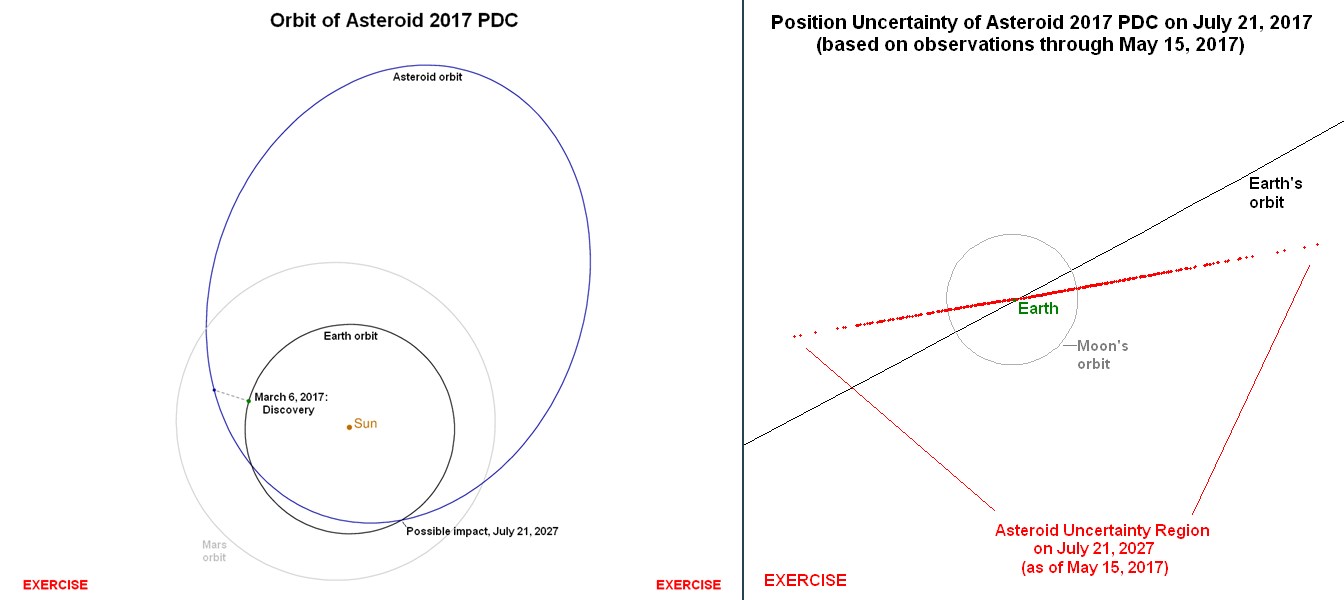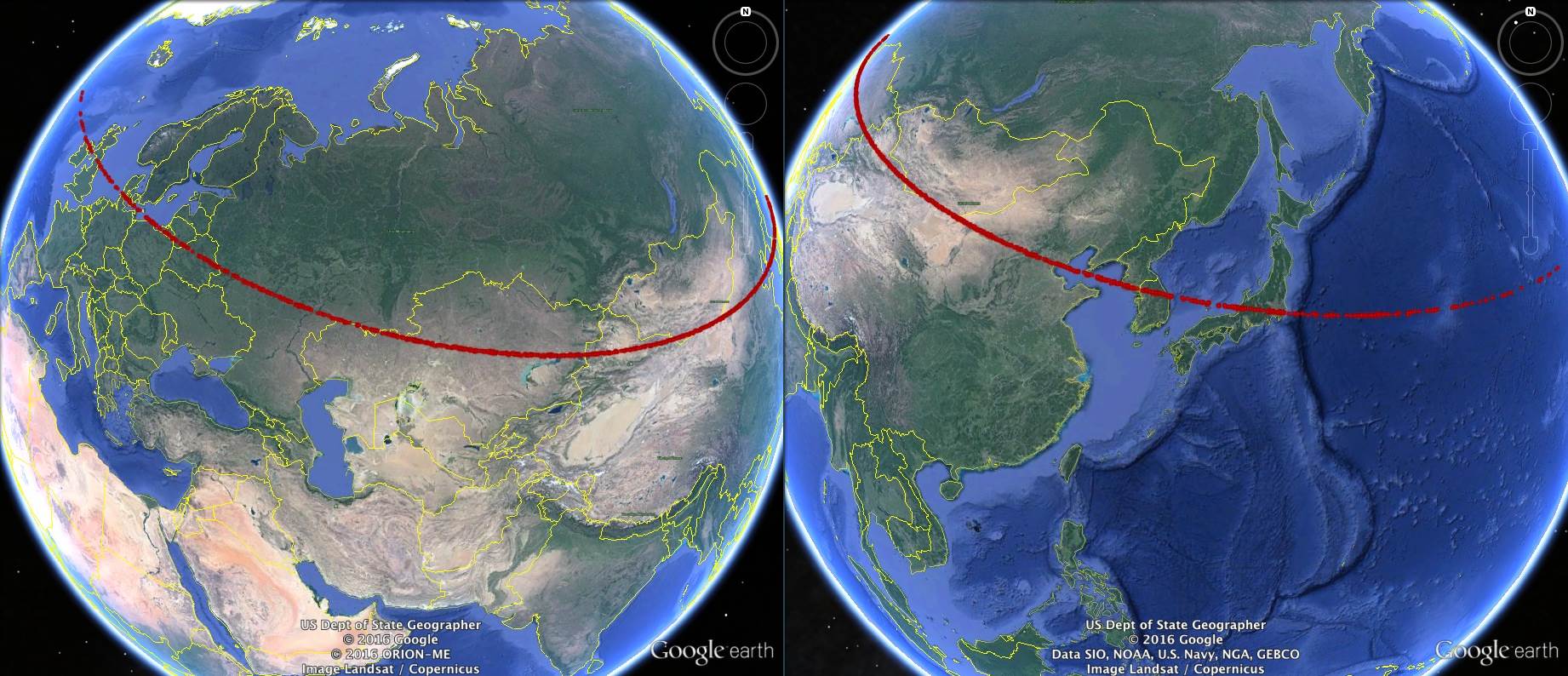・Press Release
・Press Briefing Charts
・Preliminary Summary of Mission Options
・Mark Boslough Impact Effects Briefing
・Impact Effects Simulation for Karamay China
・The taxonomy of this object (therefore approximate density) is likely known assuming that routine monitoring programs will have already yielded a spectral classification and a good lightcurve
・Hubble Space Telescope and 8-10 m class facilities on the ground should be used next year, when the object will reach magnitude 27, to get additional astrometric follow-up
・Plan to use JWST, which should be available by the end of 2018, for astrometric observations
・Check WISE data to see if the object has been seen during the current apparition, when it crossed 90° elongation, to possibly estimate the diameter and albedo (which may also solve any ambiguities of spectral class)
・Explore the possibility that ground based NIR facilities may see thermal signatures slightly above 2 microns, which would allow for a determination of the diameter
・Explore whether Gaia may be capable of providing high-precision astrometry on this object at V~20.5 (peak for the current apparition). This is too faint for the routine mode of operation of Gaia, but it may be within reach if the spacecraft is used to its limiting magnitude.
・Kick off half a dozen phase A studies (flyby, reconnaissance, kinetic impactor, etc), which will also put teams in place
・Prepare for the fast flyby mission with objectives to get shape and diameter, and to determine if the impact probability is 0 or 100
・Support deflection mission launches in 2022-2023
・Enact policies for using the nuclear deflection option in advance
・Track flight spares and off-the-shelf instruments (communication equipment, high-quality imaging camera, and a spectrometer)
・Look for options for the launch vehicle
・At 1% level, it is not recommended to start building or launching
・Request all possible observations using existing infrastructure and request political backing to get these resources
・Follow recommendations of IAWN and SMPAG
・Start planning now so that action can be taken if probability of impact goes up
・Wide range from 0 to 29 million people
・1 in 10 chance for more than 10 million people, if it impacts
・Better information is needed
・Information is needed on mass, orbit, rotation rate and subsurface structure
・Begin the development of a slow push mechanism (e.g., gravity tractor).
・Carry a small nuclear device and use it if necessary.
・If kinetic devices can be used, then a fleet of them would be necessary
・Educate the people who may be impacted
・Reach out to the respective disaster agencies and governments *Let the local disaster agencies to make the plans for evacuations
・UNCOPUOS informs all the member states as soon as practical, which then decide how to inform their own citizens
・Consistent messaging is critical - all nations/leaders should be quoting the same information.
・Our experience to date is that these probabilities will reduce ? i.e., more data will show there is no threat
・Don’t show the impact analyses/ Do show the observation opportunities
・Develop standard explanations for the jargon and terminology
・Demonstrate that we are doing everything we can to get more data
・Hubble Space Telescope observations should be made
・A flyby mission will proceed, either by diverting a spacecraft or launching a dedicated mission
・Begin investigation of a rendezvous mission
・Begin Phase A planning for redirect mission
・Use the recommended Communications Strategy
・Invest in the modeling of the impact and in developing evacuation plans
1. It is recommended to use all means to obtain better information on the impact probability and size of the object. The most suitable telescopes, including the HST, should be used. Political support from e.g. the UN should be sought to give observations of this object the highest priority.
2. As foreseen by IAWN and SMPAG a warning of the potential impact should be issued by IAWN and the assessemnt of options for a potential space mission shall be started by SMPAG and other entities in close cooperation with SMPAG. This option assessment shall address a deflection mission and a characterisation mission.
3. For a 1% chance of impact it is not recommended to start real preparations of a space mission.

Orbits of asteroid 2017 PDC, Earth and Mars. The positions of the Earth and asteroid on the day of discovery are noted. The asteroid's orbit crosses that of the Earth at the intersection point on the right. The asteroid makes over 3 orbits of the Sun between discovery and the potential impact while the Earth makes over 10 orbits about the Sun. In other words, the potential impact occurs the third time the asteroid passes through the orbit intersection point after discovery.

This pair of images shows the risk corridor as of May 15, 2017, traced by the red dots. In the unlikely event that 2017 PDC were to impact the Earth, it would impact somewhere within the region traced by the red dots.
・The asteroid is first detected by the Pan-STARRS Survey on March 6, 2017. The apparent magnitude at discovery is 21.0. After a second night of observations, the Minor Planet Center (MPC) announces the discovery, designates the asteroid “2017 PDC” and publishes an initial orbit in a Minor Planet Center Electronic Circular (MPEC). The MPC computes a small MOID (Minimum Orbit Intersection Distance), ~0.001 au, and predicts a close approach of about 0.13 au in late April.
・On March 8, JPL’s Sentry system and the NEODyS group’s CLOMON systems both detect a small chance of impact for this asteroid in 2027: the probability of impact is on the order of 1 in a million. The asteroid is added to the online risk pages for both of these systems. Over the following week, the asteroid continues to be observed, and estimates of its orbit become more accurate. The daily reports from Sentry and CLOMON show a slowly increasing probability. Ten days after discovery, the impact probability reaches about 1e-4, and the asteroid moves up to level 1 (green) on the Torino Scale.
・On May 15, 2017 (the first day of the 2017 Planetary Defense Conference), the impact probability reaches 1 percent, and the asteroid moves to rating 4 on the Torino Scale (yellow).
・2017 PDC makes a close approach to the Earth on April 27, 2017 at a fairly distant 0.13 au. It will not approach this close again until its very close encounter in 2027.
・Radar observations are attempted on April 27, but the asteroid is not detected. Radar astronomers are confident that the asteroid would have been detected if it were any larger than 300 meters in size.
Background information on the scenario.
To study this scenario using the JPL HORIZONS system, click here.
Description of NASA/JPL NEO Deflection App.
Using the Deflection App for the PDC 2015 scenario.